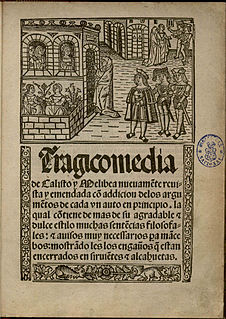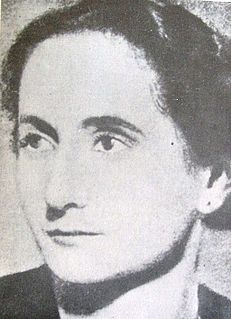See also
| This disambiguation page lists articles associated with the title Celestina. If an internal link led you here, you may wish to change the link to point directly to the intended article. |
Celestina may refer to:
In arts and entertainment:
People:
| This disambiguation page lists articles associated with the title Celestina. If an internal link led you here, you may wish to change the link to point directly to the intended article. |
Juan Ruiz, known as the Archpriest of Hita, was a medieval Castilian poet. He is best known for his ribald, earthy poem, Libro de buen amor.

Spanish literature generally refers to literature written in the Spanish language within the territory that presently constitutes the Kingdom of Spain. Its development coincides and frequently intersects with that of other literary traditions from regions within the same territory, particularly Catalan literature, Galician intersects as well with Latin, Jewish, and Arabic literary traditions of the Iberian peninsula. The literature of Spanish America is an important branch of Spanish literature, with its own particular characteristics dating back to the earliest years of Spain’s conquest of the Americas.

Francisco Delicado was a Spanish writer and editor of the Renaissance. Little is known about his life. He was born in Cordoba, Spain and, by uncertain reasons, he moved to Rome, where he became vicar and Italianized his surname to Delicado. After the sack of Rome, he went to Venice where he wrote his novel Portrait of Lozana: The Lusty Andalusian Woman, that continues on the lines of the novel in dialogue exemplified by Celestina. The book is a social and historical portrait of Rome and its dark side in the first years of the 16th century, and one of the first works of the picaresque novel. He was also a disciple of Antonio de Nebrija and editor of books such as Amadis de Gaula (1533), Celestina (1531–1534), Primaleon (1534) and some medical treatises like El modo de adoperare el legno de India and De consolatione infirmorum.

The Portrait of Lozana: The Lusty Andalusian Woman is a book written in Venice by the Spanish editor of the Renaissance, Francisco Delicado, in 1528, after he escaped from Rome due to the anti-Spanish sentiment that uprose after the sack of Rome a year earlier. Published anonymously, the book contains a description of the life in Rome's underworld during the first third of the 16th century. It is considered a book descendant of Celestina because of the literary genre, the novel in dialogue, and one of the earliest manifestations of the picaresque novel.

The Tragicomedy of Calisto and Melibea, known in Spain as La Celestina is a work entirely in dialogue published in 1499. It is attributed to Fernando de Rojas, a descendant of converted Jews, who practiced law and, later in life, served as an alderman of Talavera de la Reina, an important commercial center near Toledo.

Fernando de Rojas was a Spanish author and dramatist, known for his only surviving work, La Celestina, first published in 1499. It is variously considered "the last work of the Spanish Middle Ages or the first work of the Spanish Renaissance".

The Spanish Renaissance was a movement in Spain, emerging from the Italian Renaissance in Italy during the 14th century, that spread to Spain during the 15th and 16th centuries.
Margaret Sayers Peden was an American translator and professor emerita of Spanish at the University of Missouri. She lives and works in Columbia, Missouri.
Spanish Renaissance literature is the literature written in Spain during the Spanish Renaissance.

Celestina is an eighteenth-century English novel and poet Charlotte Turner Smith’s third novel. Published in 1791 by Thomas Cadell, the novel tells the story of an adopted orphan who discovers the secret of her parentage and marries the man she loves. It is a courtship novel that follows the typical Cinderella plot while still commenting on contemporary political issues.
Dorothy Sherman Severin AB, AM, PhD, FSA, OBE is Emeritus Professor of Literature at University of Liverpool and a Hispanist. Her research interests include cancioneros and La Celestina.

María Rosa Lida de Malkiel, born Maria Rosa Lida, was an Argentine philologist. Notable as an Hispanist medievalist, she came to the United States on a Rockefeller Foundation program of study. Beginning in 1947, Lida de Malkiel lectured for many years in the US, including at Harvard University, the University of California at Berkeley, and Stanford. An advisor to the editorial boards of two professional journals, in the 1950s she was admitted to the Real Academia Española and the Academia Argentina de Letras.

Terra Nostra is a 1975 novel by the Mexican writer Carlos Fuentes. The narrative covers 20 centuries of European and American culture, and prominently features the construction of El Escorial by Philip II. The title is Latin for "Our earth". The novel received the Xavier Villaurrutia Award in 1976 and the Rómulo Gallegos Prize in 1977.
The Wanton of Spain is a 1969 Spanish drama film directed by César Fernández Ardavín. The film was selected as the Spanish entry for the Best Foreign Language Film at the 42nd Academy Awards, but was not accepted as a nominee. It was also entered into the 6th Moscow International Film Festival.

La Celestina P... R... is a 1965 Italian comedy film directed by Carlo Lizzani. It is loosely based on the Medieval novel La Celestina by Fernando de Rojas.
Celestina Cordero, was an educator who in 1820 founded the first school for girls in San Juan, Puerto Rico.

La Celestina is a 1996 Spanish drama directed by Gerardo Vera and written by Rafael Azcona, Gerardo Vera and Francisco Rico based on 1499 novel of the same title by Fernando de Rojas. Starring Penélope Cruz, Terele Pávez and Juan Diego Botto.
Teresa Marta Ruiz Penella, better known as Terele Pávez, was a Spanish actress. She appeared in more than ninety films since 1954.
La Celestina is a work entirely in dialogue published in 1499.
Stephen Gilman was an American Hispanist, known for his work on the 15th-century novel La Celestina.